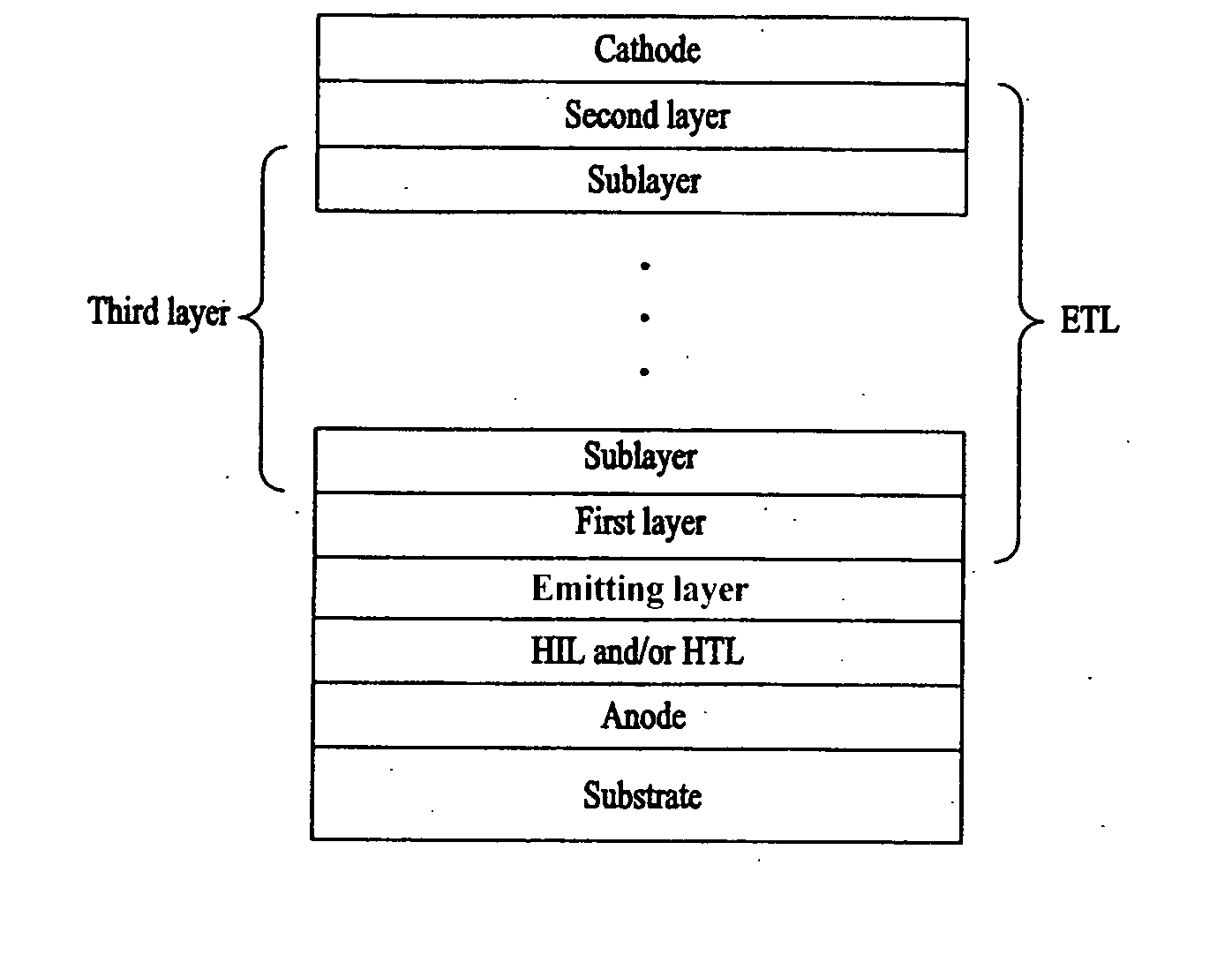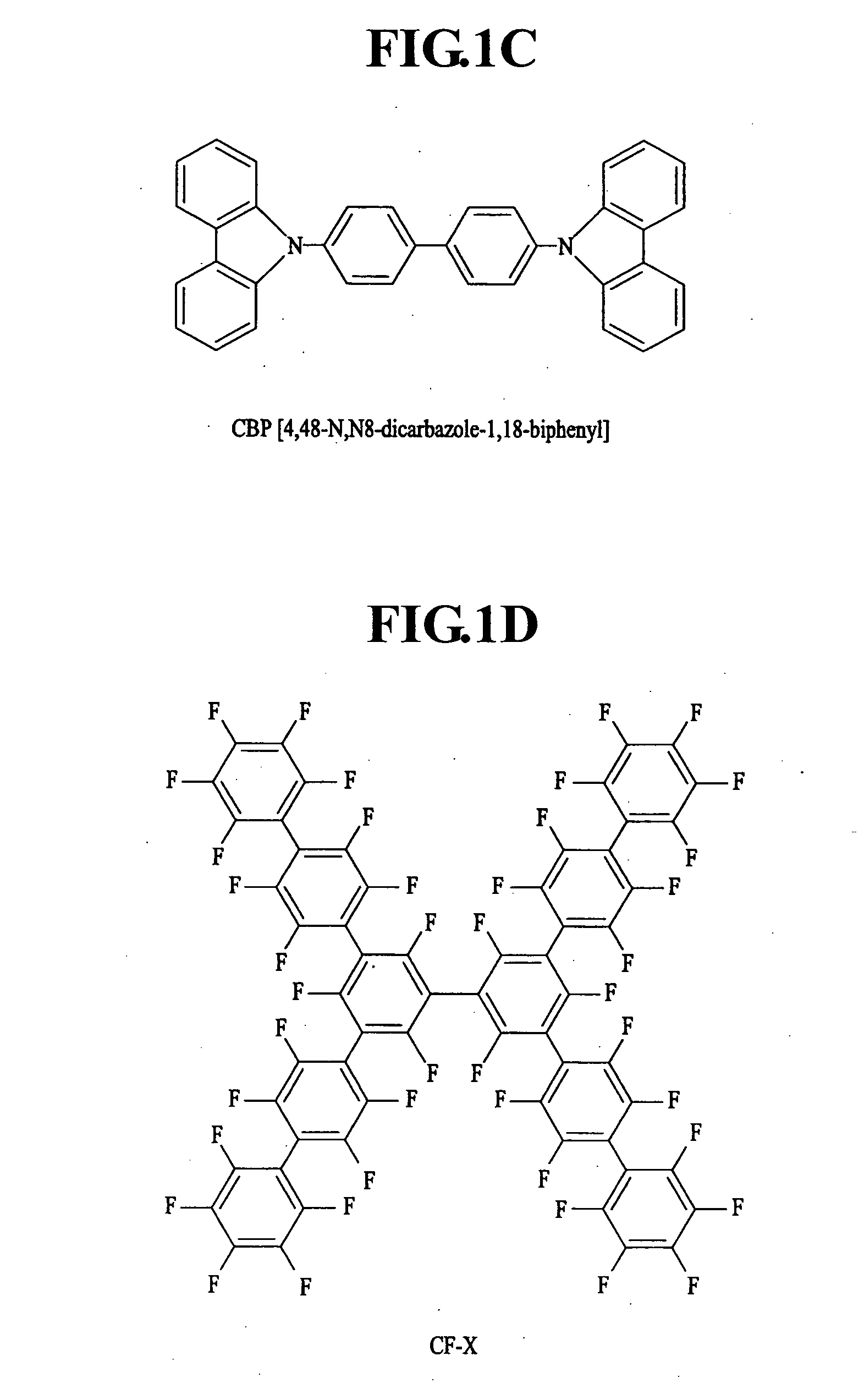Organic electroluminescence device and method for fabricating the same
a technology of electroluminescent devices and organic el, which is applied in the direction of discharge tubes/lamp details, luminescent screens for discharge tubes, natural mineral layered products, etc., can solve the problems of service life and efficiency of organic el devices, and achieve the effect of improving service life and efficiency
- Summary
- Abstract
- Description
- Claims
- Application Information
AI Technical Summary
Benefits of technology
Problems solved by technology
Method used
Image
Examples
example 1
[0083] 1) An anode made of Indium Tin Oxide (ITO) is formed on a transparent substrate, and a hole-injection layer (HIL) made of copper phthalocyanine (CuPc) is applied on the anode to a thickness of about 25 nm.
[0084] 2) A hole-transport layer (HTL) is formed by applying 4,4′bis[N-(1-naphthyl)-N-phenyl-amino]biphenyl (NPD)on the HIL to a thickness of about 35 nm.
[0085] 3) In order to prepare a green-emitting layer, 8-hydroxyquinoline aluminum (Alq3), doped with about 1% CO6, is applied on the HTL to a thickness of about 25 nm.
[0086] 4) Alq3 (Device A) or Balq (Device B) is applied on the emitting layer to a thickness of about 35 nm to form an electron-transport layer (ETL).
[0087] 5) LiF is applied on the ETL to a thickness of about 0.5 nm to form an electron-injection layer (EIL).
[0088] 6) Aluminum (Al)is applied on the EIL to a thickness of about 150 nm to form a cathode.
[0089] A comparison of IVL characteristics between the Device A and Device B as fabricated in this manner...
example 2
[0092]FIG. 10 is a sectional view of an organic EL device in accordance with an embodiment of the invention.
[0093] 1) An ITO anode is formed on a transparent substrate, and a hole-injection layer (HIL) made of copper phthalocyanine (CuPc) is applied on the anode to a thickness of about 25 nm.
[0094] 2) 4,4′bis[-(1-naphthyl)-N-phenyl-amino]biphenyl (NPD)is applied on the HIL to a thickness of about 35 nm to form a hole-transport layer.
[0095] 3) In order to prepare a green-emitting layer, 8-hydroxyquinoline aluminum (Alq3), doped with about 1% C545T, is applied on the HTL to a thickness of about 25 nm.
[0096] 4) An electron-transport layer (ETL) is formed on the emitting layer by applying Alq3 having superior electron mobility and Balq having superior hole blocking ability to a thickness of about 35 nm on the emitting layer, in a 3:7 volume % ratio of Balq and Alq3 Device C), or in a 5:5 volume % ratio of Balq and Alq3 Device D), or in a 7:3 volume % ratio of Balq and Alq3 (Device E...
example 3
[0102] Hereinafter, another example of an electron-transport layer which may be utilized in the present invention will be described with respect to FIG. 13.
[0103] The device shown in FIG. 13 was fabricated using BeBq2 as an electron-transporting material and Balq as a hole-blocking material. The electron-transporting capabilities of BeBq2 is superior to that of Alq3 as used previously, and thus performance of the device could be further enhanced.
[0104] 1) First, an ITO anode is formed on a transparent substrate, and a hole-injection layer (HIL) is formed by applying copper phthalocyanine (CuPc) to a thickness of about 25 nm on the anode.
[0105] 2) A hole-transport layer (HTL) is formed by applying 4,4′bis[N-(1-naphthyl)-N-phenyl-amino]biphenyl (NPD) to a thickness of about 35 nm on the HIL.
[0106] 3) In order to prepare a green-emitting layer, 8-hydroxyquinoline aluminum (Alq3), doped with about 1% C545T, is applied on the HTL to a thickness of about 25 nm.
[0107] 4) Next, an elec...
PUM
| Property | Measurement | Unit |
|---|---|---|
| thickness | aaaaa | aaaaa |
| thickness | aaaaa | aaaaa |
| thickness | aaaaa | aaaaa |
Abstract
Description
Claims
Application Information
 Login to View More
Login to View More - R&D
- Intellectual Property
- Life Sciences
- Materials
- Tech Scout
- Unparalleled Data Quality
- Higher Quality Content
- 60% Fewer Hallucinations
Browse by: Latest US Patents, China's latest patents, Technical Efficacy Thesaurus, Application Domain, Technology Topic, Popular Technical Reports.
© 2025 PatSnap. All rights reserved.Legal|Privacy policy|Modern Slavery Act Transparency Statement|Sitemap|About US| Contact US: help@patsnap.com



